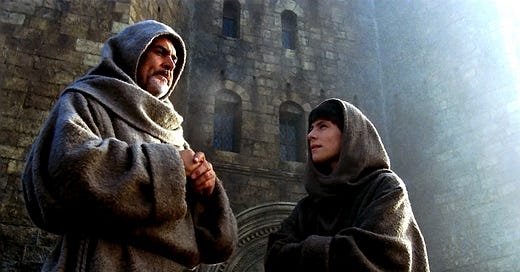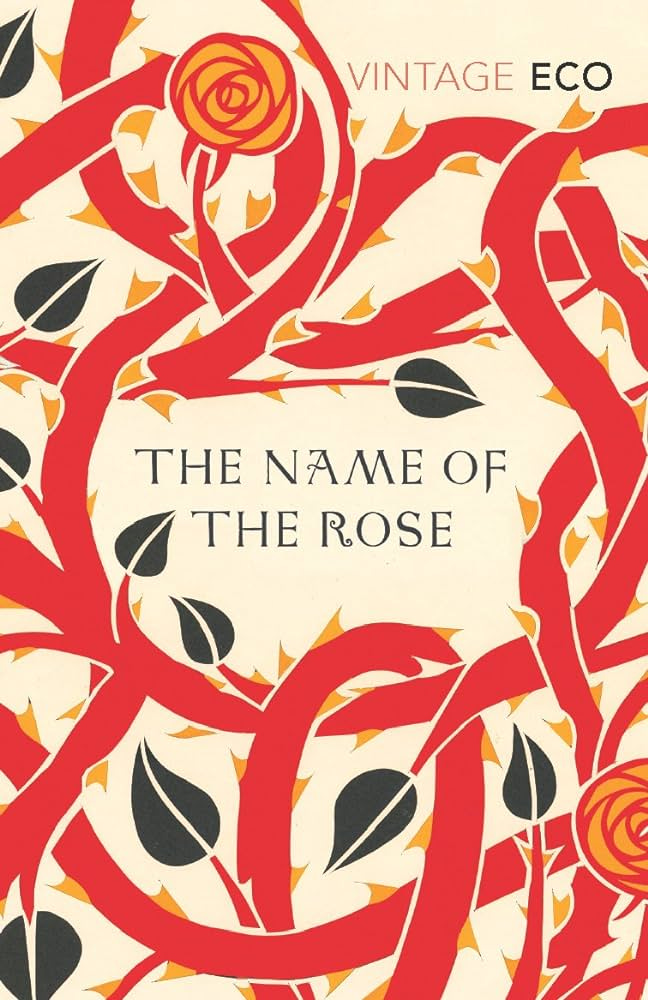“Often books speak of other books. Often a harmless book is like a seed that will blossom into a dangerous book, or it is the other way around: it is the sweet fruit of a bitter stem.”
There is a temptation when we encounter literature of reputation and difficulty that the fault of our limited impression on a first reading lies with the author. How could they be so unforthcoming? Is their obscurity meant to impress us, or only the initiated? Shouldn’t fine art be like fine crystal? Say what you mean and mean what you say; say it with an ironic wink at the reader and anticipate the naivety that will colour today’s words with tomorrow’s certainties. Do we demand too much and read too quickly?
Umberto Eco is an author who pays his readers the compliment of not deferring to them too much. As he admits in the novel’s postscript, the first 100 pages of The Name of the Rose are a penance the reader must suffer if he is to be deemed worthy and enter the labyrinth of mysteries that lie beyond. To force your reader to atone for their modern sensibilities is a piece of wisdom few if any publishers would recommend. But Eco’s penance is perhaps a good recent example of what Harold Bloom described as at once the most authentic motive for reading the canon and a definition of the Sublime - ‘the search for a difficult pleasure’. To the mind of this mortal reader, in the presence of literary gods, the pleasurable difficulty of The Rose is a testament to the uncompromising ideal of what a novel can still be.
Although the book retains the reputation it slowly built since the 80’s, from literary curio to international bestseller, would even the most ardent fans of this novel believe that the same story would be such a triumph in the 2020’s? In an age of unceasing novelty, of frivolous, perpetual images and videos that measure our attention in fractions of a second - ‘for images are the literature of the layman’ - of film trailers that spoil the plot in order to entice you in and justify the production value (if not the writing, acting or story), what a rare honour The Rose is in contrast.
According to Eco, the idea for his novel arose from a friend who was soliciting detective stories written not by authors, but by sociologists, politicians and academics, to be published in a small magazine. Eco said ‘no’, as firstly, he was convinced that he could not write dialogues… and secondly, that if he did write such a story, it would be 500 pages long and take place in a medieval monastery…
As he writes in the masterful postscript to the novel:
‘The writer (or painter or sculptor or composer) always knows what he is doing and how much it costs him. He knows he has to solve a problem. Perhaps the original data are obscure, pulsive, obsessive, no more than a yearning or a memory. But then the problem is solved at the writer’s desk as he interrogates the material on which he is working — material that reveals natural laws of its own, but at the same time contains the recollection of the culture with which it is loaded (the echo of intertextuality).’
Steeped in decades of reading and academic research, Eco set himself a number of problems in writing The Rose, problems which the reader is invited to understand if not necessarily reconcile by the end of the book. Occasionally, the questions that are raised, most often by the Franciscan sleuth William of Baskerville who seems to only be missing the eponymous deerstalker hat and clay pipe, do weigh the narrative down and detract from the pacing. References are made, names are mentioned, theological mysticism is invoked, often heaped up on a few successive pages before returning to the juicy murders. But even if we do not follow all we read, an atmosphere is conjured by the medieval Romantic style which would undoubtedly be diminished by a modern retelling, echoing down the 14th century cloisters.
Which leads on to the film of the book, starring Sean Connery as William of 221B Baker St. For the film adaptation is the diminished contemporary translation, inverting the literary device of the murder plot employed by Eco to explore in depth ideas of history, theology and mysticism, used in the film as a means of explaining the murders. This is no criticism, for though the scope of the film is obviously much more direct, it is excellent in itself and sates the longing some of us have to know more of the atmosphere of this obscure and mystical age.
Those evocative images, the ‘layman’s literature’, of the monastery on a remote mountain top like a sentinel of learning above, the dense rolling fog of ignorance and hunger of the peasants in the valley below, and the scraps of knowledge and food that are discarded and ‘trickle down’ to the unwashed masses at the foot of the mountain, all is well represented in the film. And though the theology may be secondary, the dialectical battle between the Franciscan and Benedictine traditions is also beautifully captured in the fiery metaphor that ends the story - teaching us both the danger of intellectual pride and rapacious curiosity, and the equal danger of seeking to preserve and selectively disseminate knowledge with a greedy heart.






